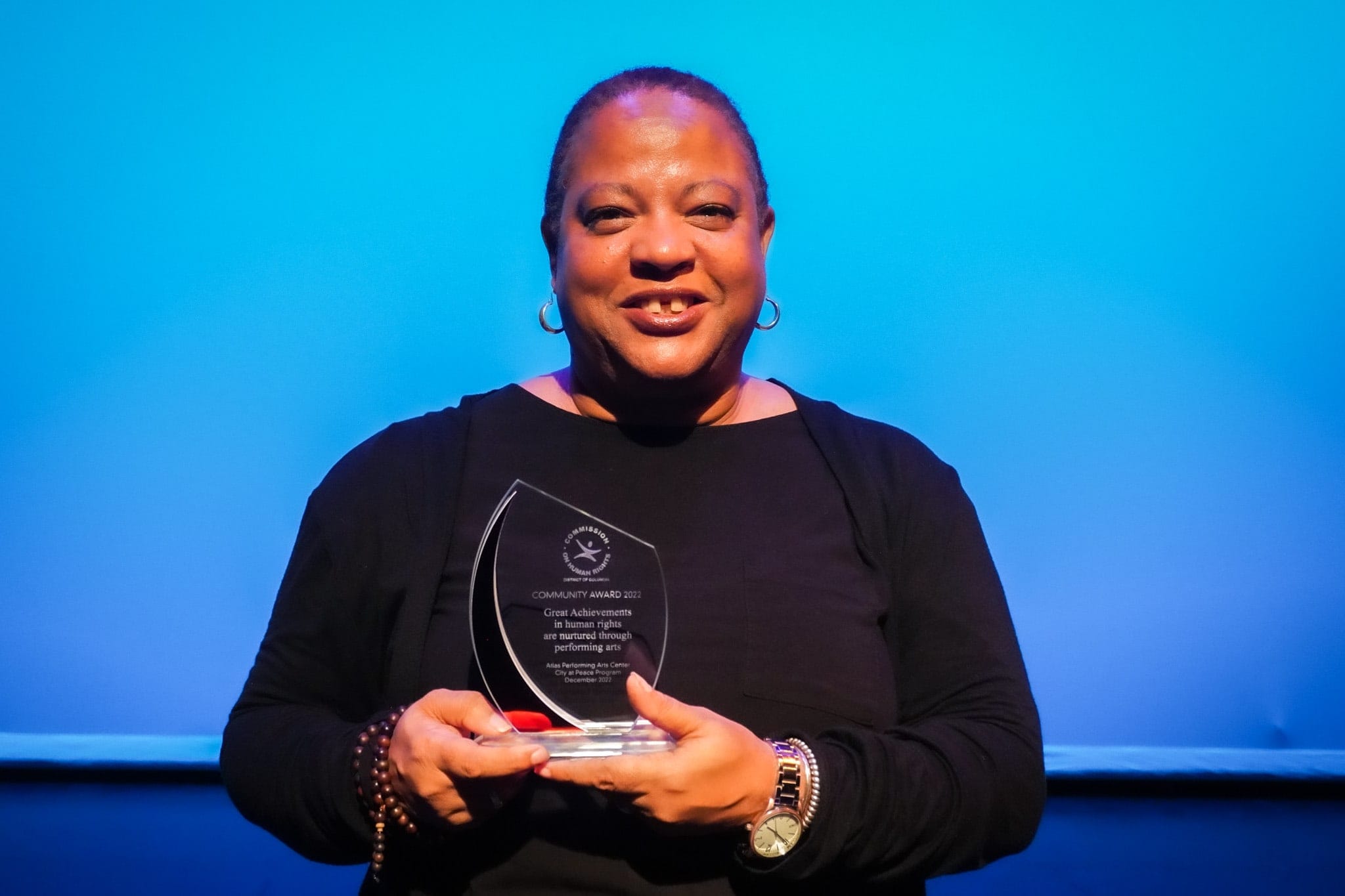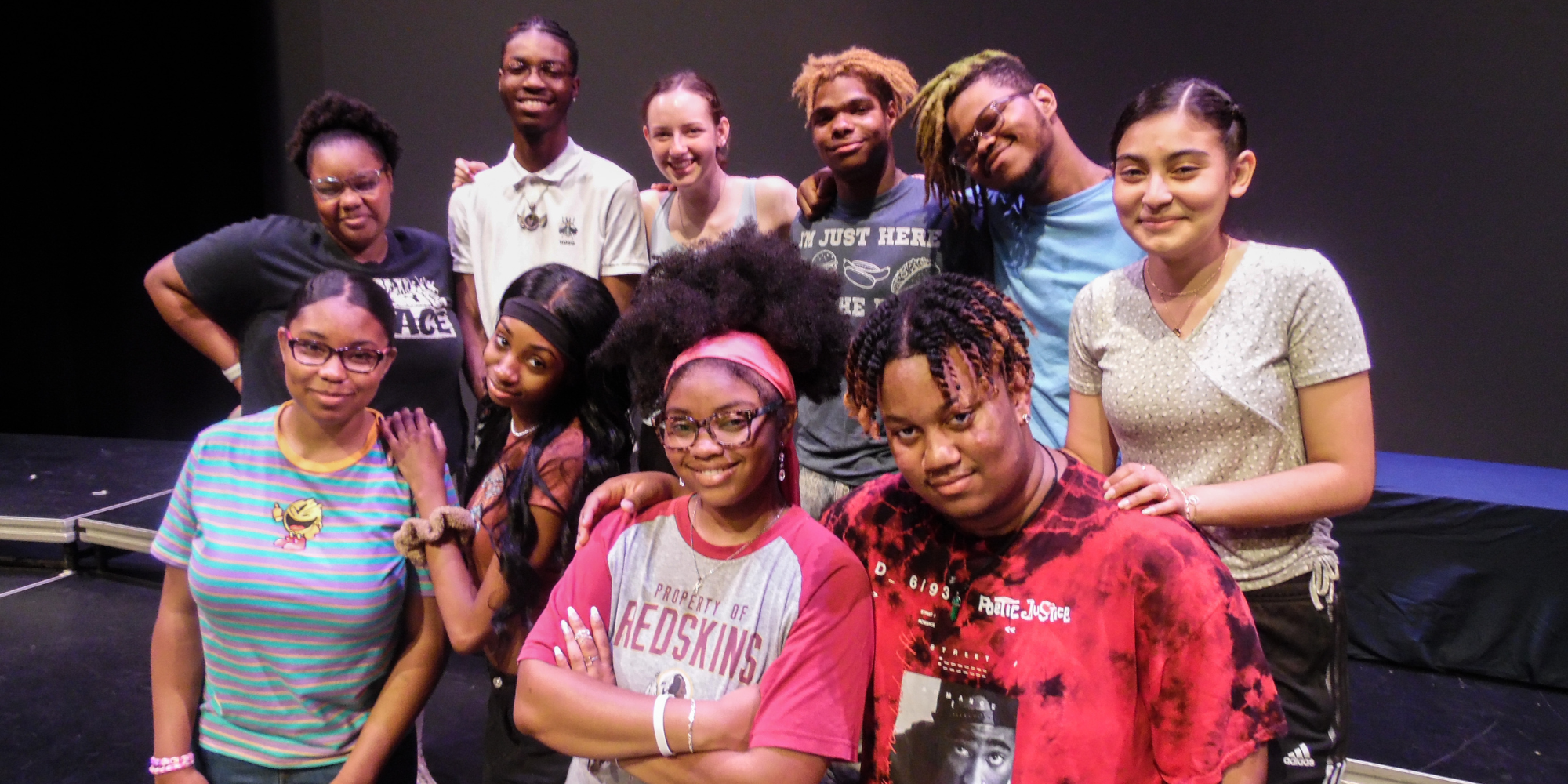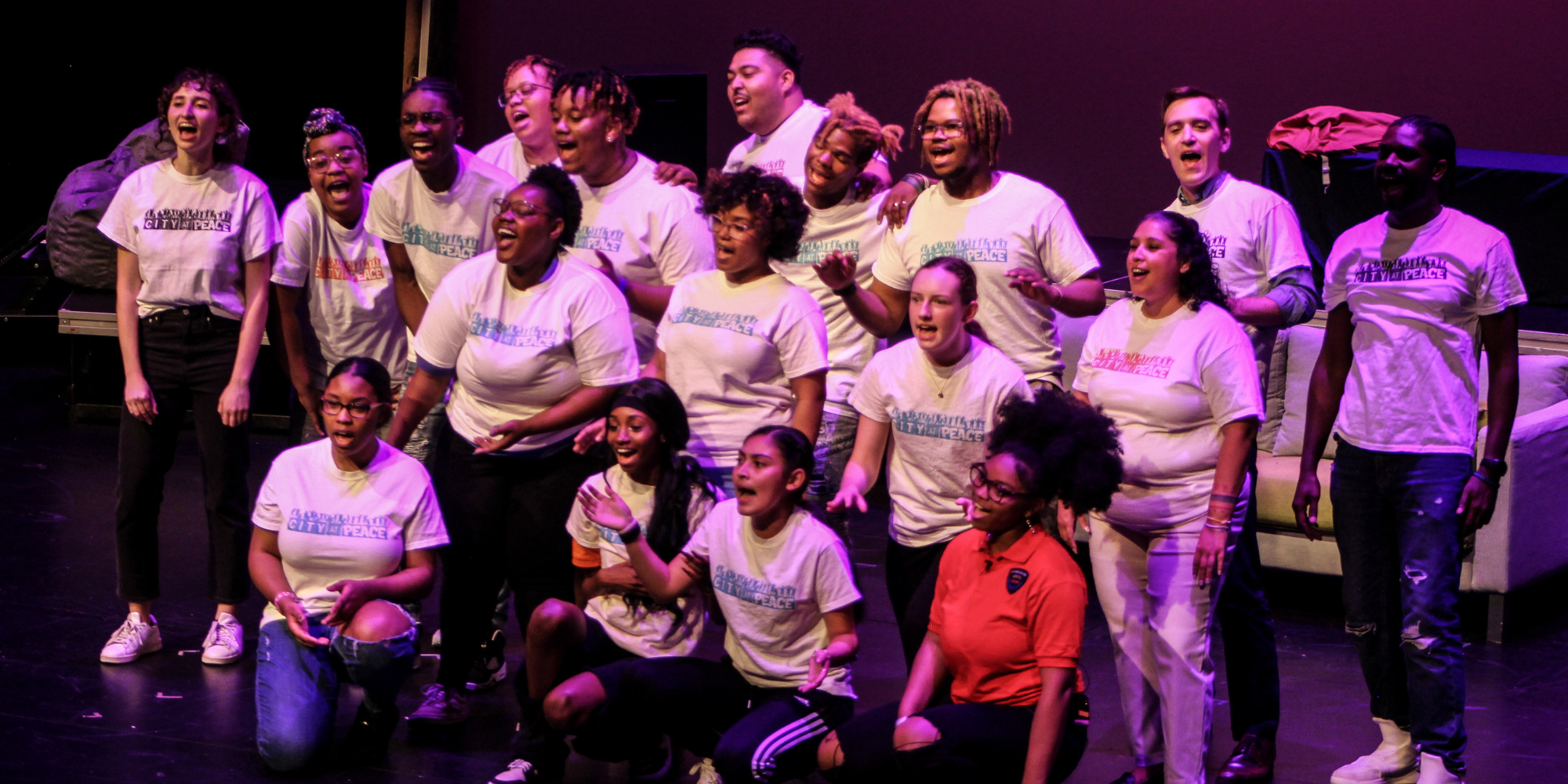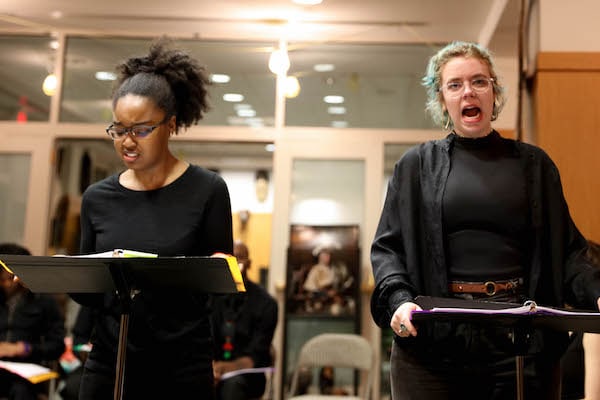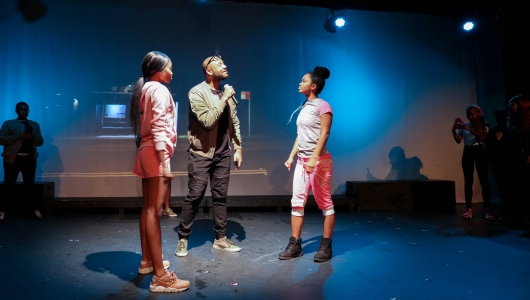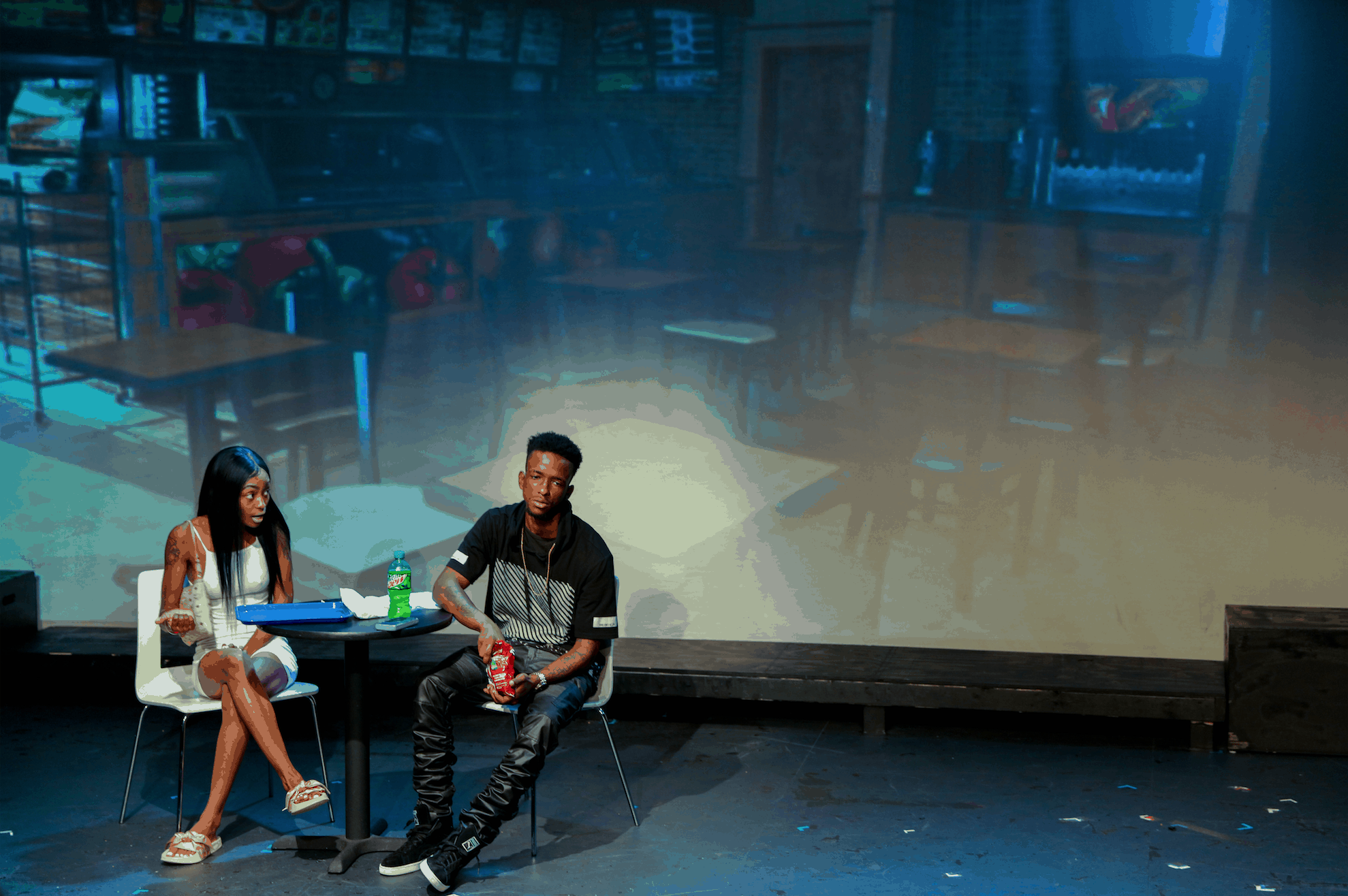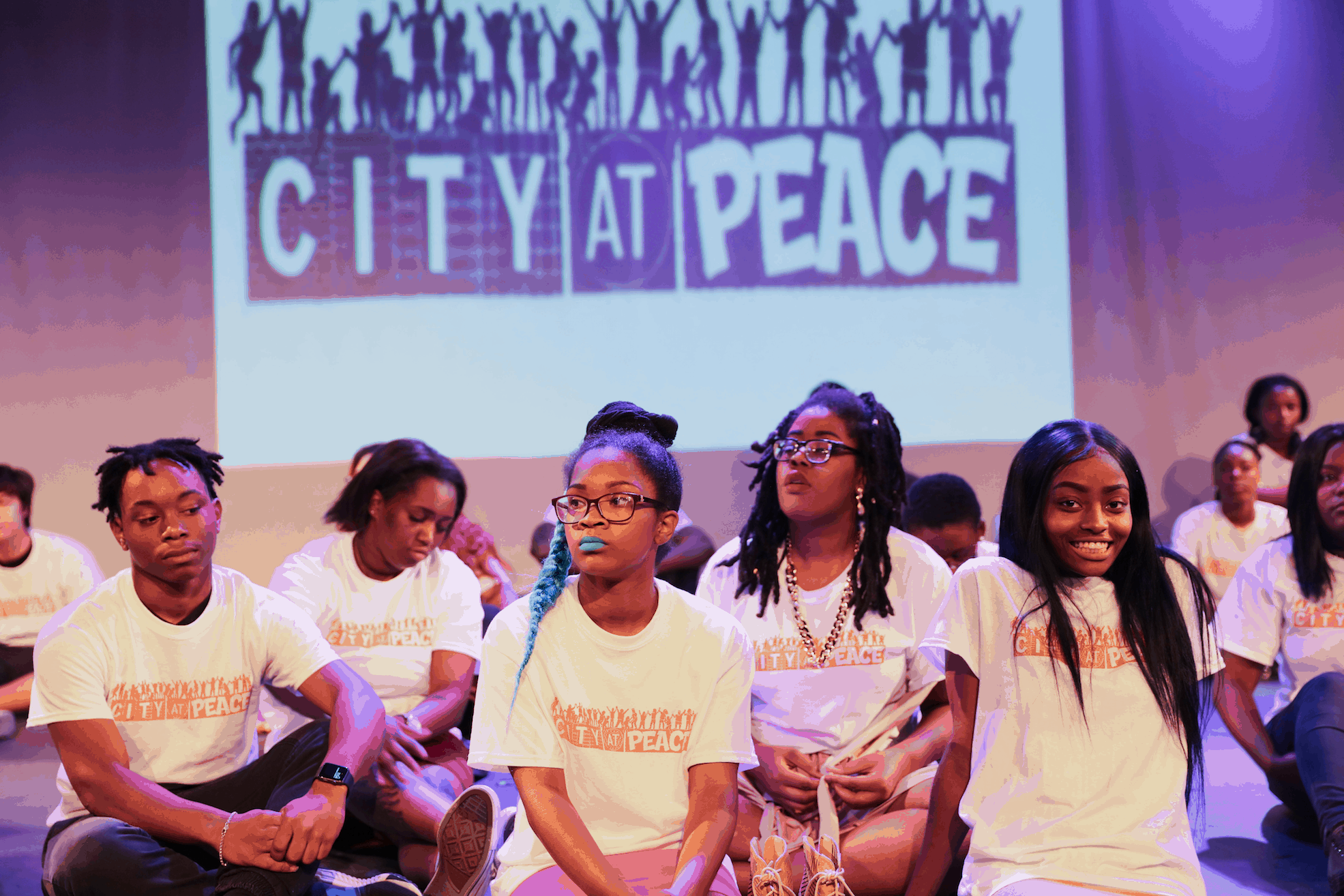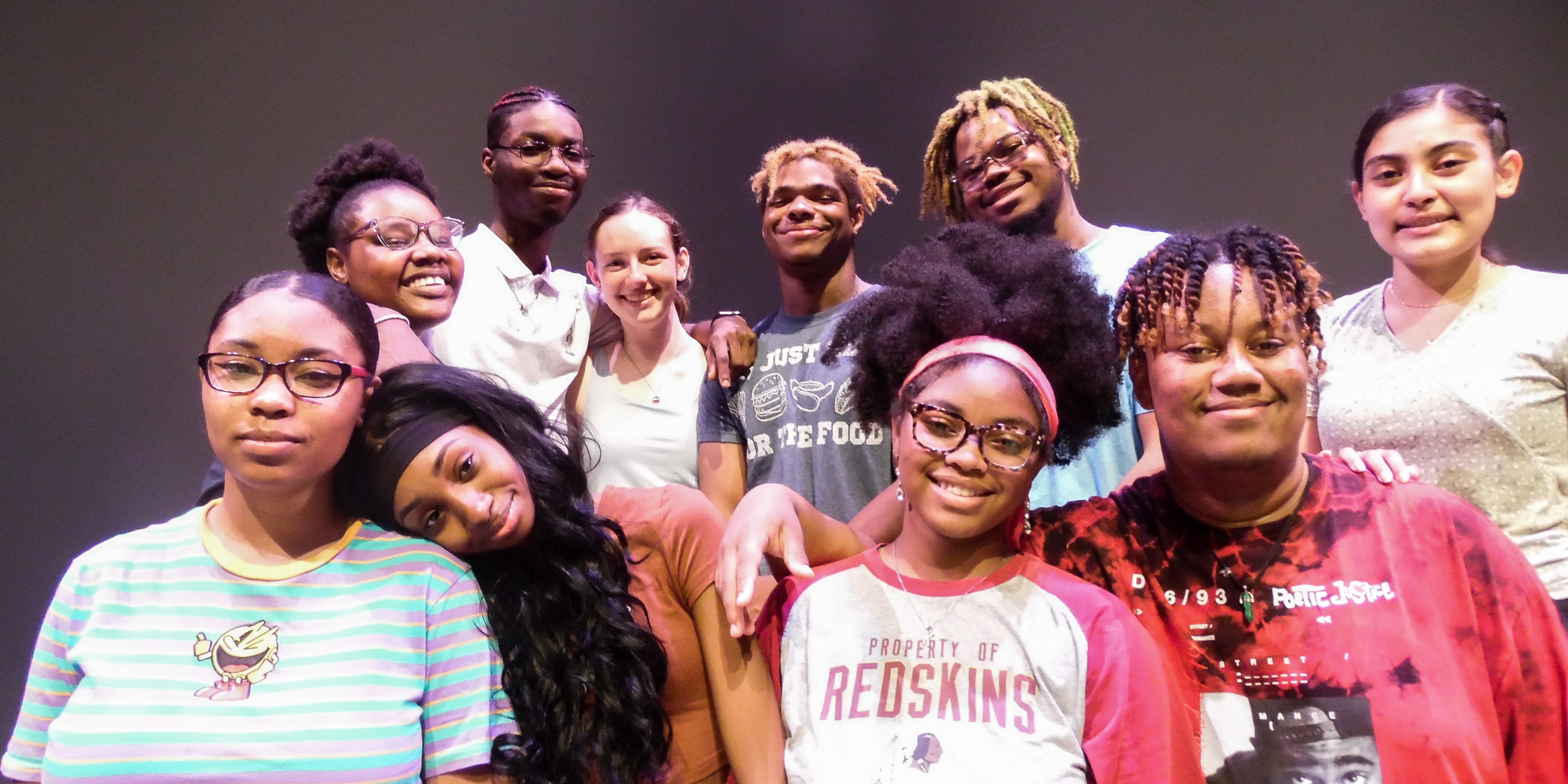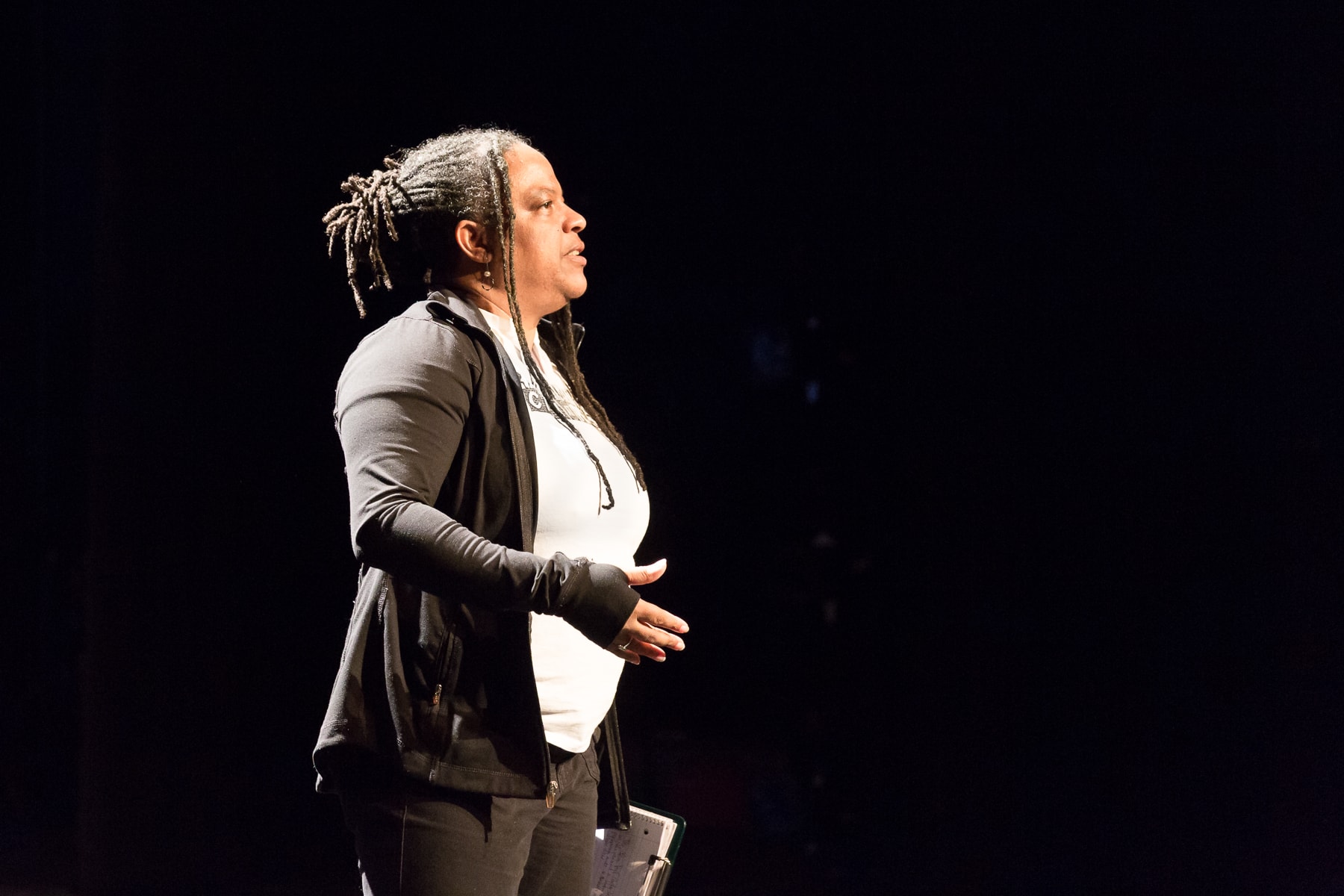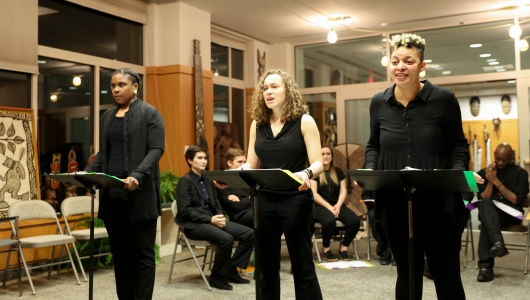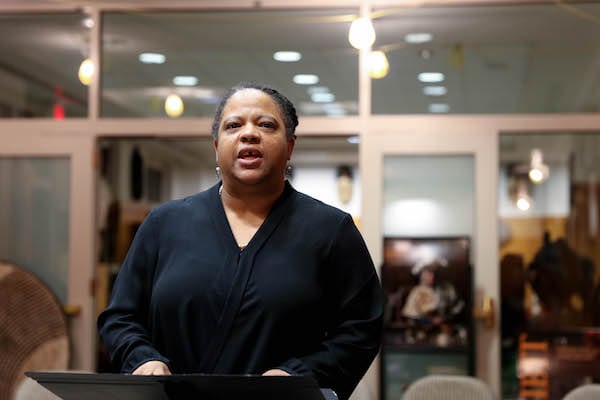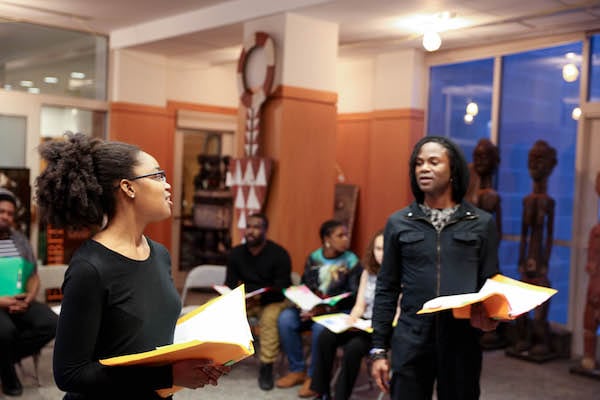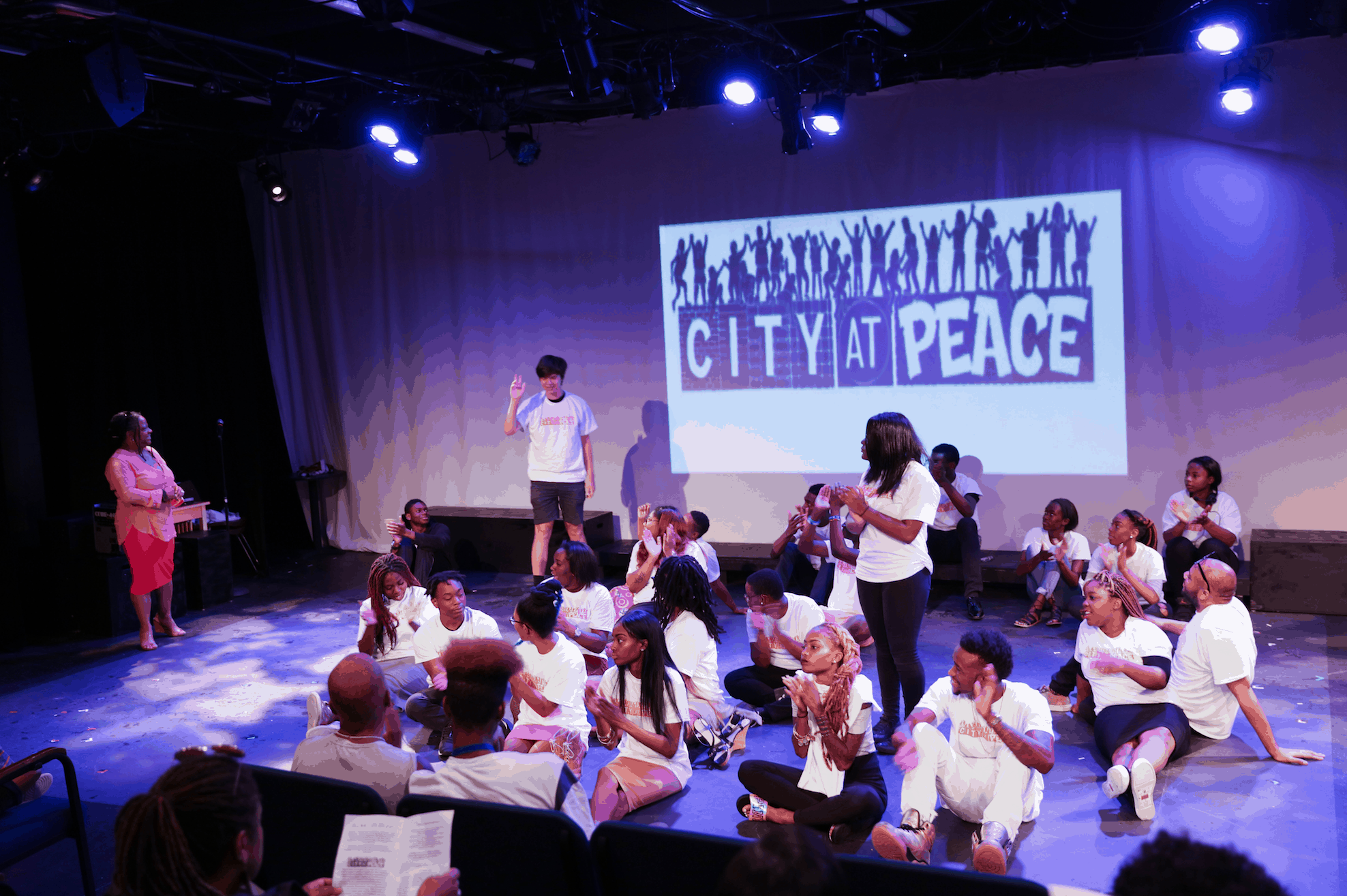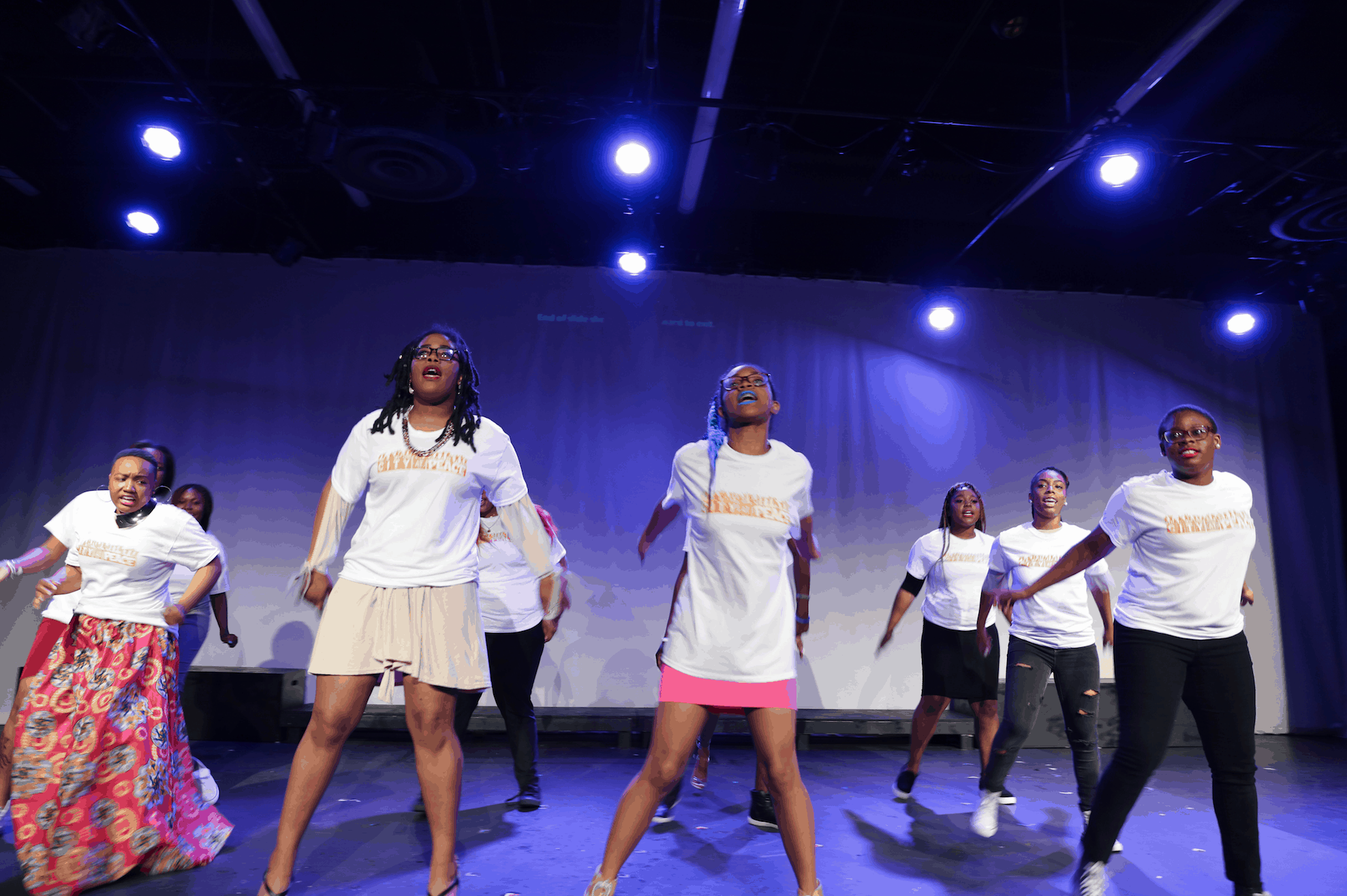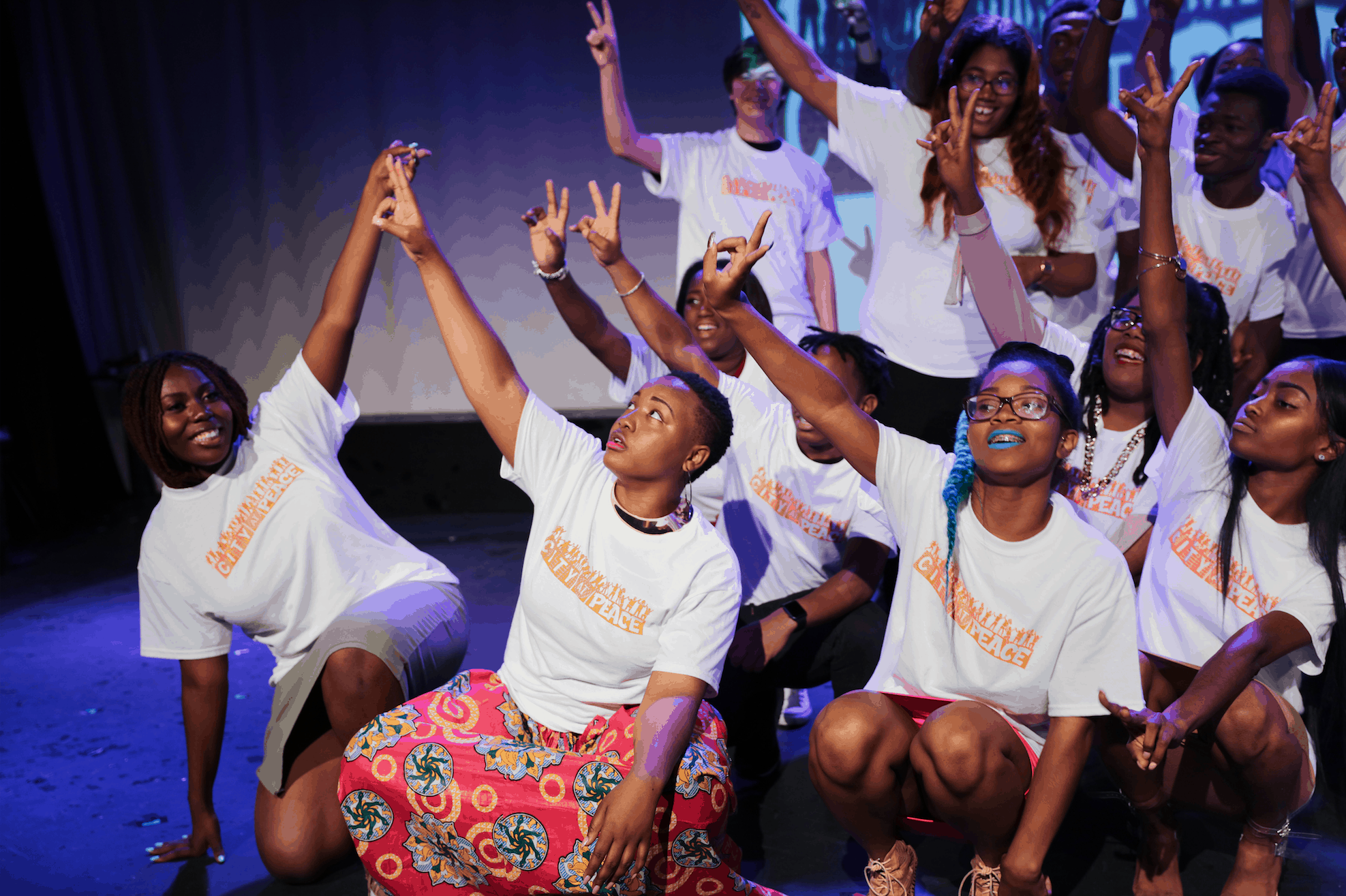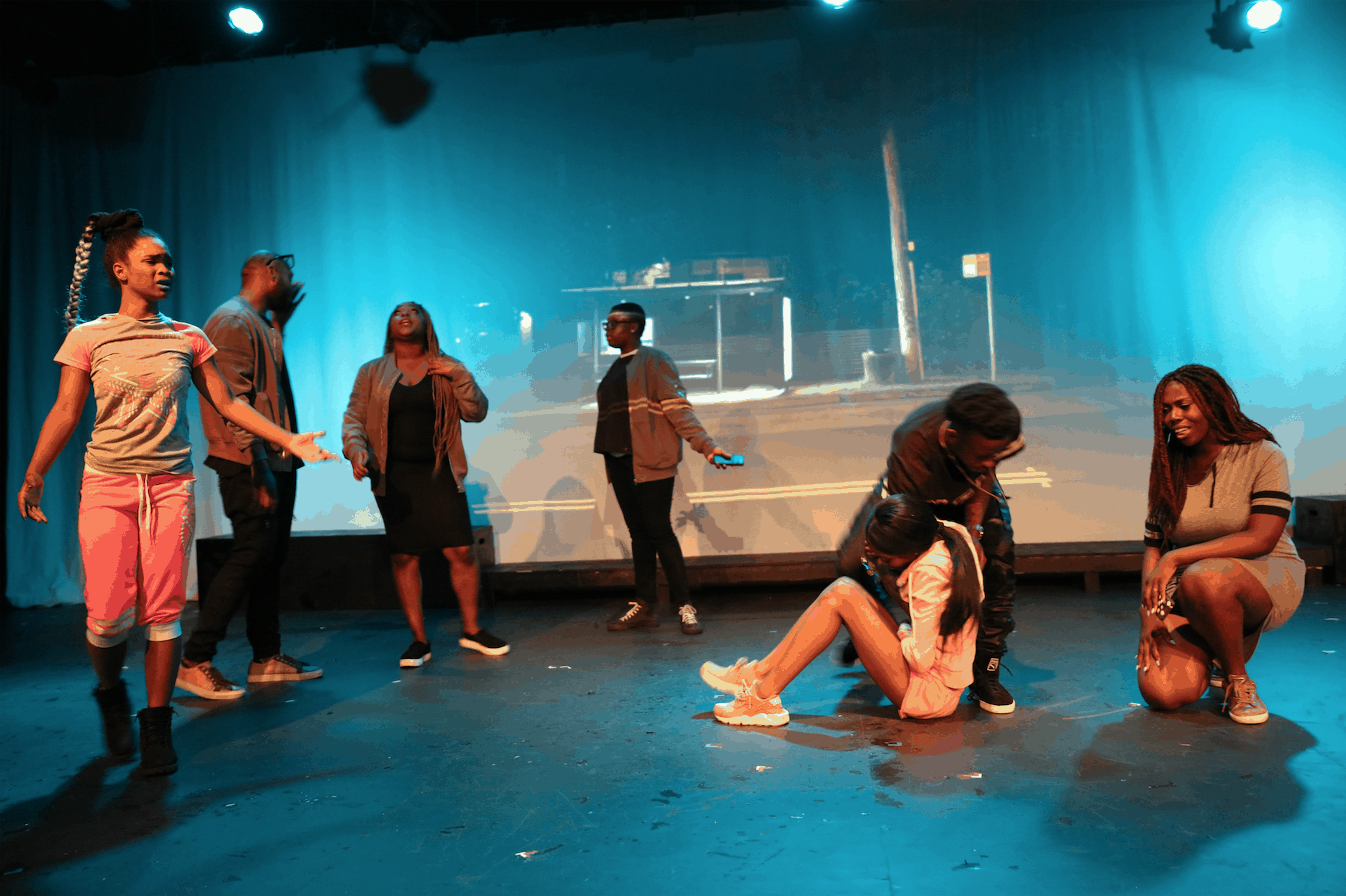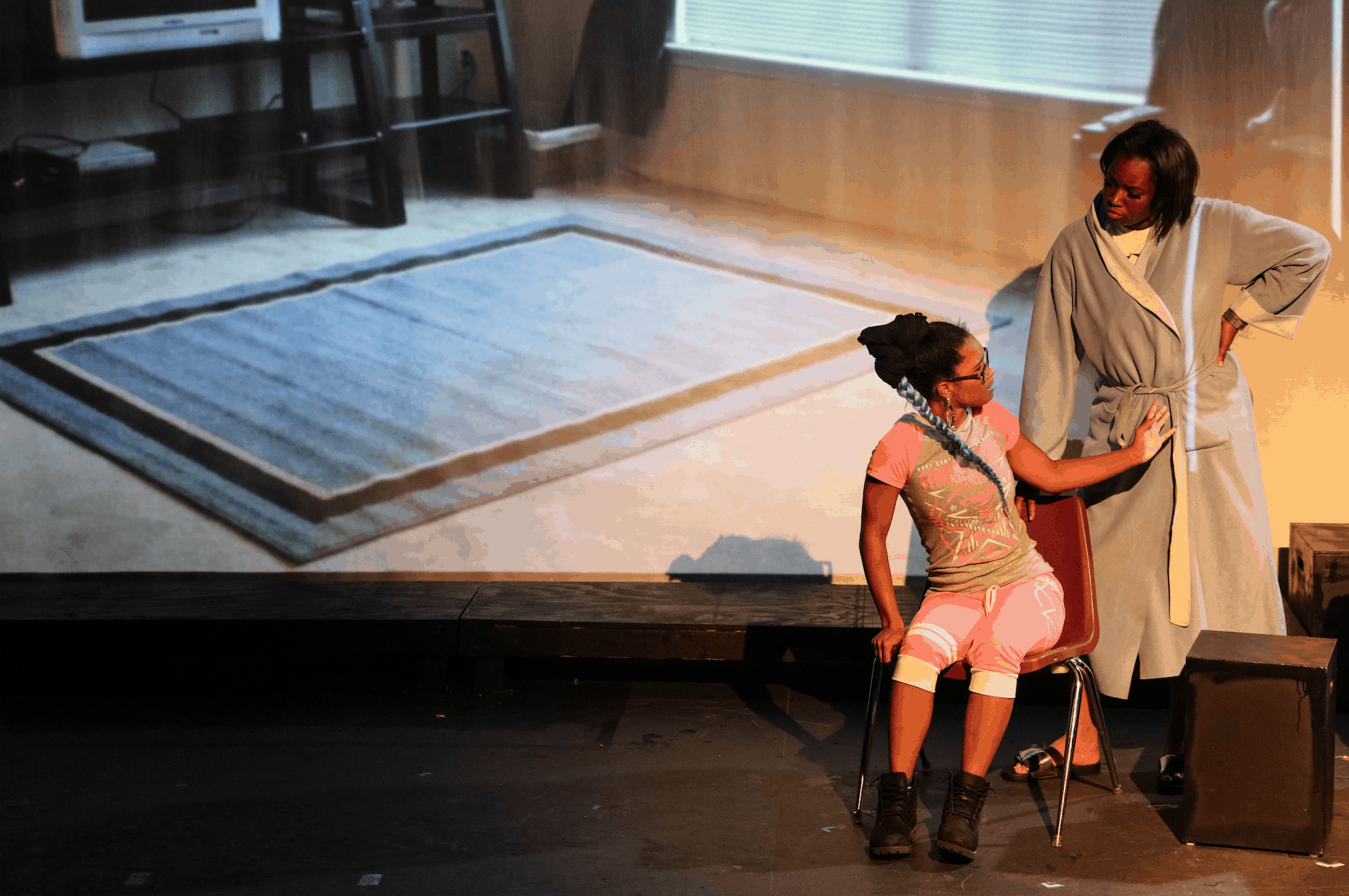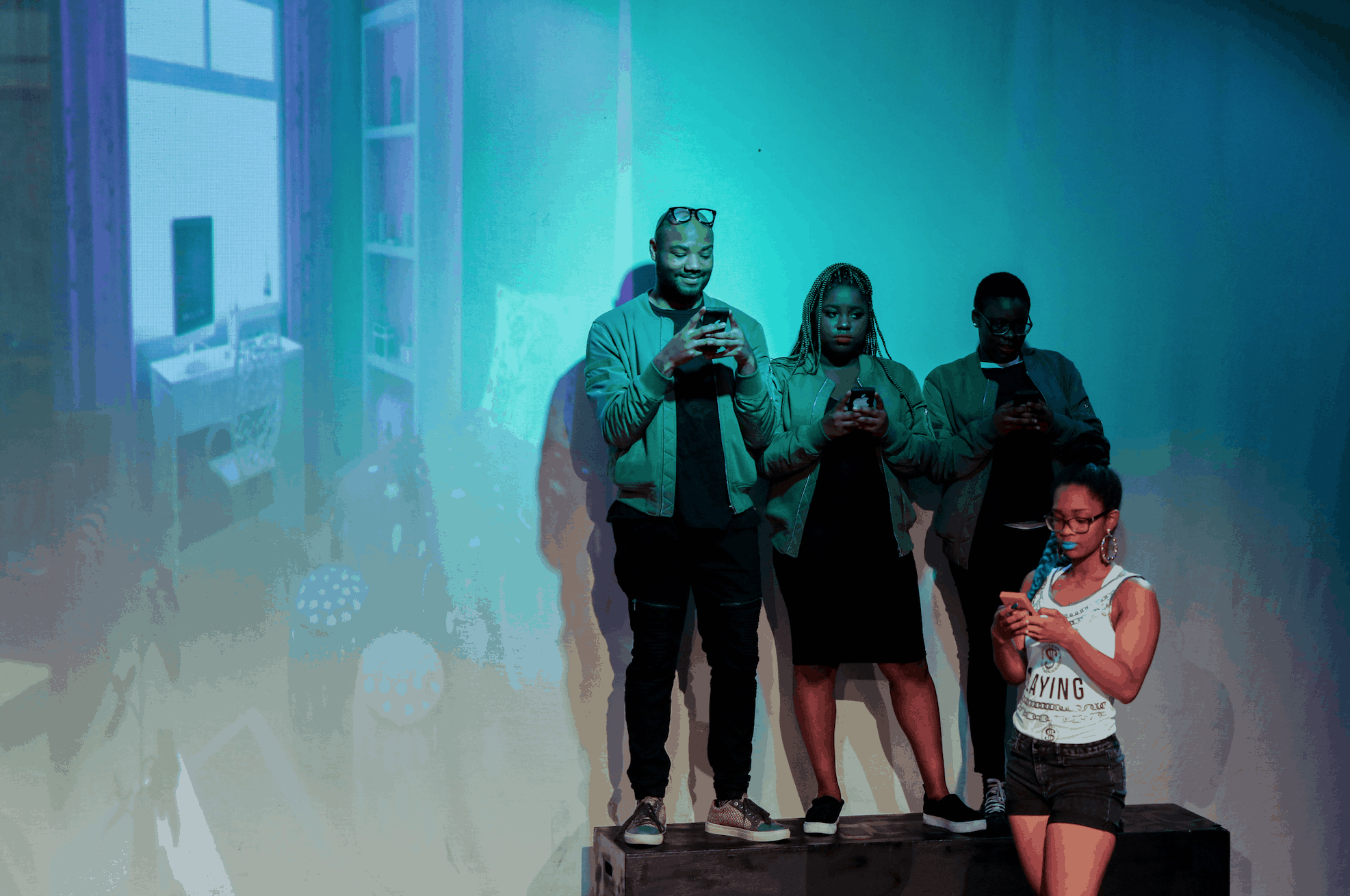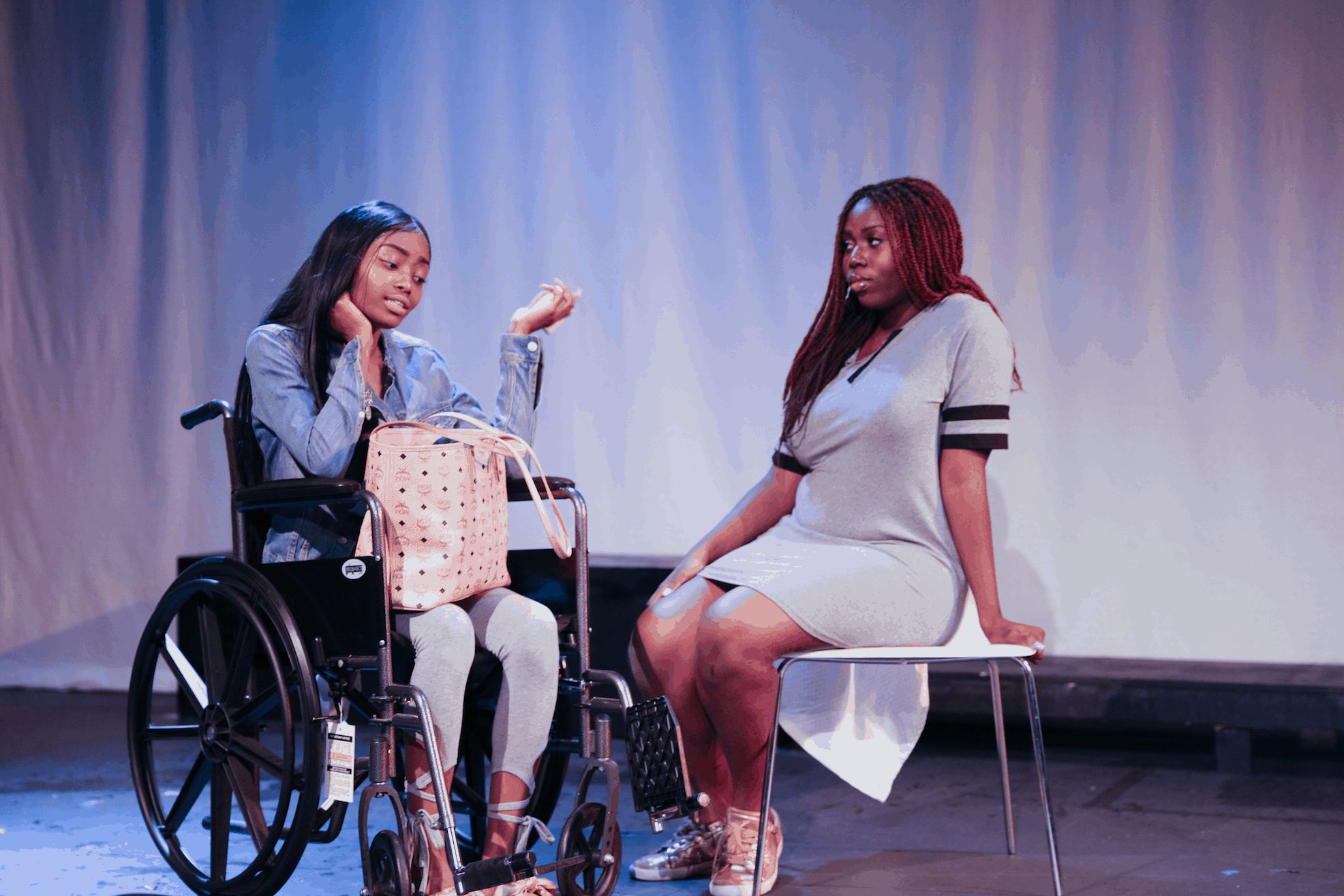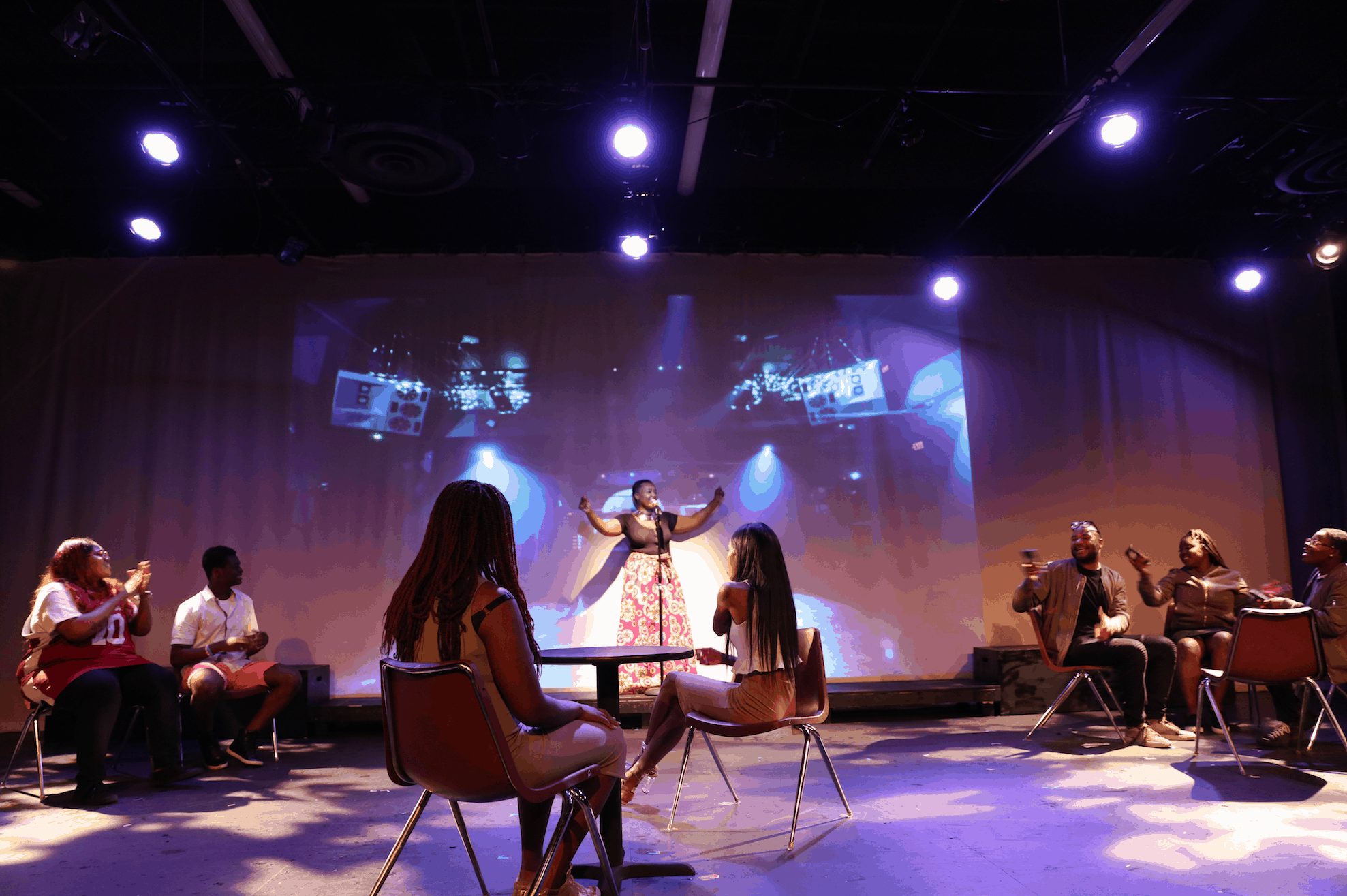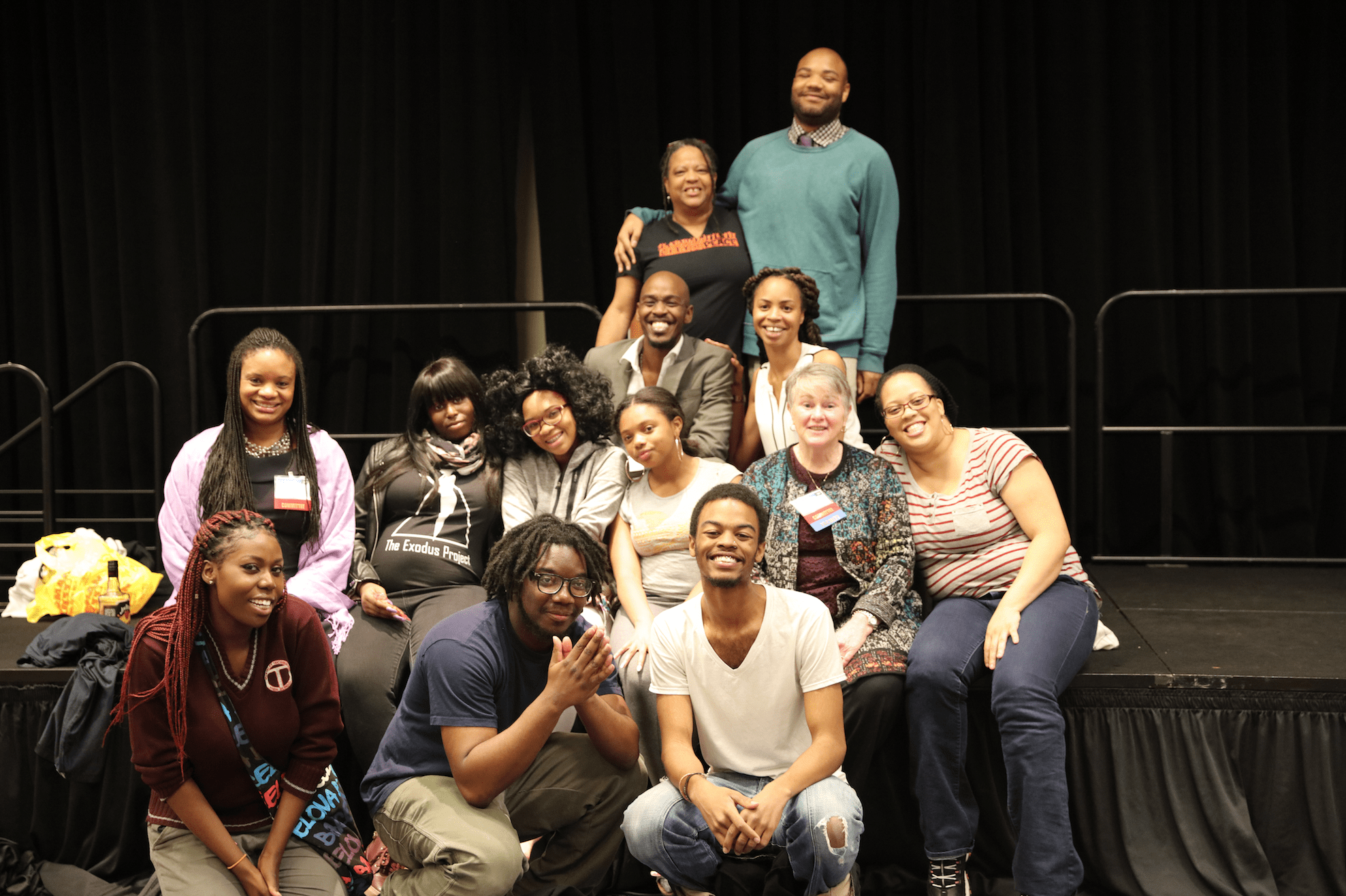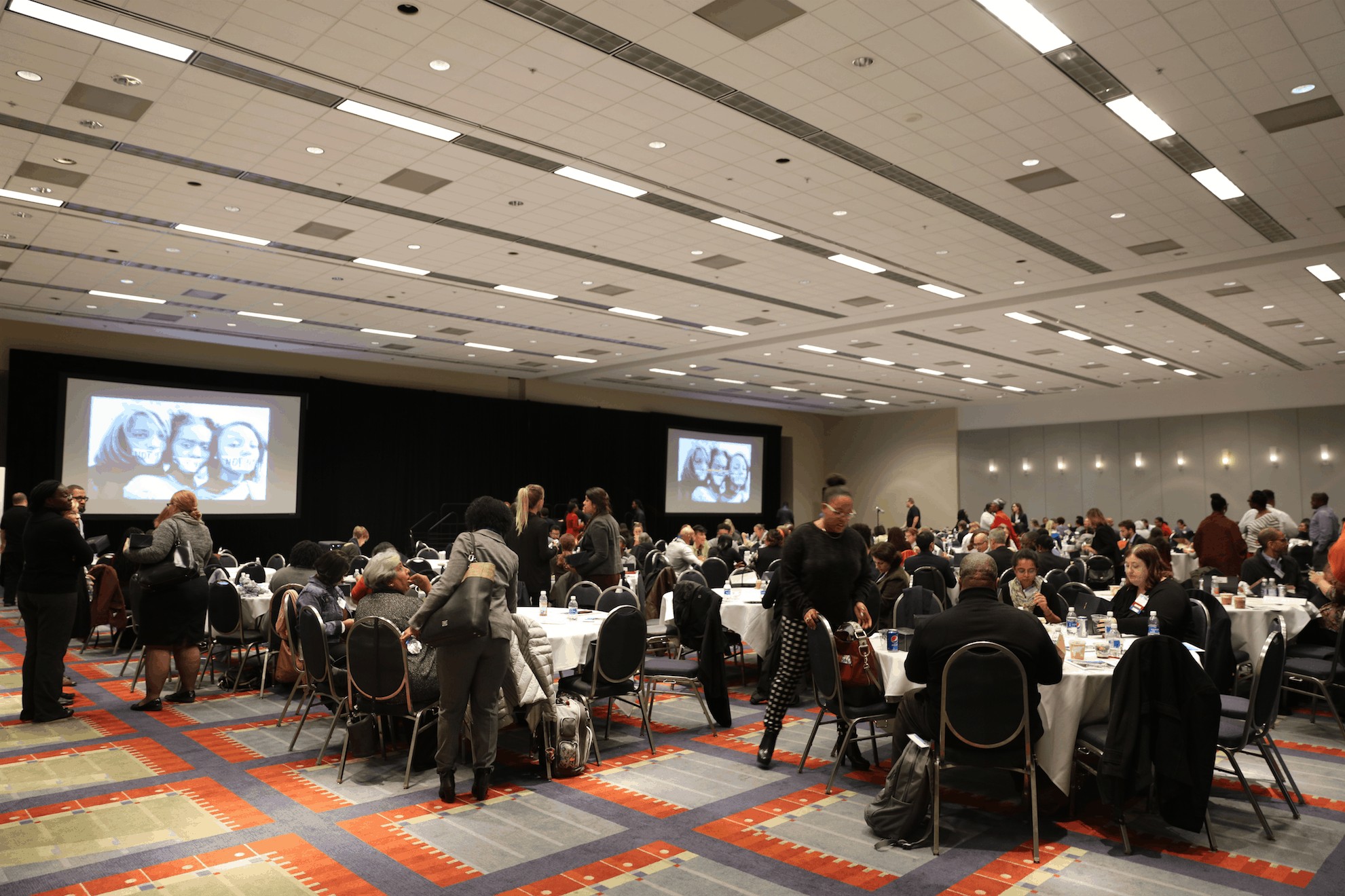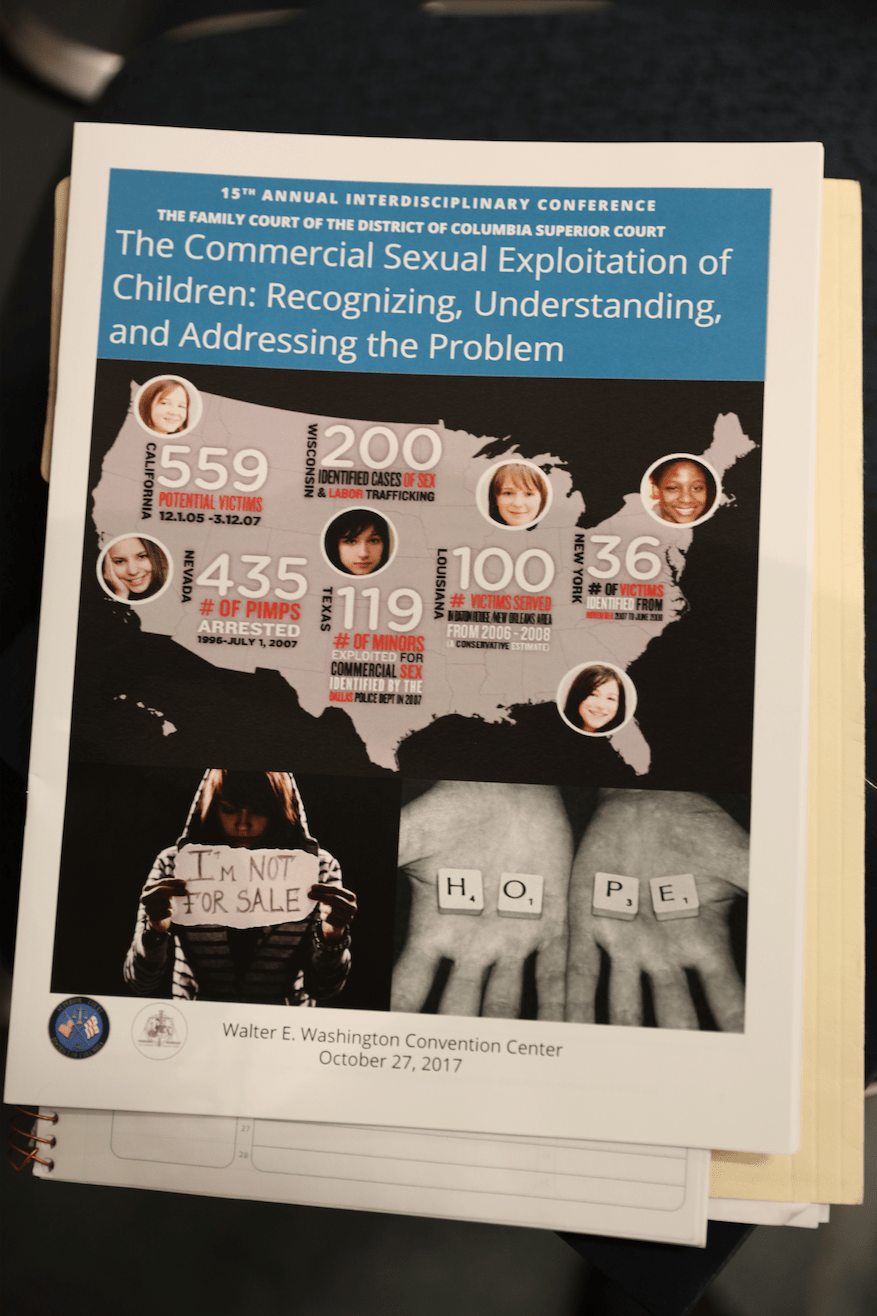City at Peace
CITY AT PEACE
Summer Youth Employment Program (SYEP)
Earn money and valuable work experience for ages 16 – 24.
City at Peace (CAP) is a youth development program, which provides a safe, collaborative and nurturing space for young people to examine systems of oppression that marginalize based on race, gender, age, ethnicity, sexuality, and values. Rooted in social justice, City at Peace uses performing arts as a learning tool to develop skills in dance, theatre, voice, and stage production, as well as skills in conflict resolution, personal storytelling, empathy, understanding, and leadership. Based on their experiences, City at Peace participants will create an artistic production that shares their ideas for change in a performance.
This program is free for participants. Funding is provided by major institutional and individual donor support including the DC Commission on the Arts & Humanities, Learn24/ Office of Out of School Time Grants and Youth Outcomes.
PARTICIPANTS: Ages 16-24
All genders, all races, all sexual orientations, all classes, artists and non-artists, activists, poets, dancers, actors builders, and dreamers. Expect to meet youth from different schools and neighborhoods in the DMV with questions, concerns, and ideas about race, gender, ethnicity, sexuality, and the role they play in society. Bring your concerns, creativity, and ideas for change.
Summer Program Dates, Days and Times
Start Date – Monday, June 24, 2024
Program End Date – Friday, August 2, 2024
City at Peace Summer Program meets Monday thru Friday
Session time-9am-3pm
No session- Thursday, July 4, 2024
Summer Performances/Presentations
City at Peace Presents
Thursday, August 1, 2024
Friday, August 2, 2024
APPLY HERE
The Program Director is an acclaimed facilitator, artist, and educator, Sandra Holloway, reachable for all questions at sholloway@atlasarts.org.
Sandra Holloway is the artistic director of City at Peace in Washington, DC, a youth development organization that uses the performing arts to teach and promote cross-cultural understanding and non-violent conflict resolution. Each year, she leads groups of diverse teenagers through intensive training in theater, dance, and music, as well as peace-building across race, class, gender, religion, and culture, culminating in a full-length musical based on their own lives, written and performed by the young people themselves (telling each others’ stories). Holloway was featured as one of six choreographic artists in Black Expressions at Washington, DC’s Lincoln Theatre, and has worked professionally at the Kennedy Center, the Theatre of the First Amendment, George Mason University, The Studio Theater, and Dance Place. She attended the University of the Arts in Philadelphia, winning awards for her choreography and receiving her BFA in Dance/Choreography.
CITY AT PEACE
Earn community service hours and valuable work experience for ages 14 – 24.
City at Peace (CAP) is a youth development program, which provides a safe, collaborative and nurturing space for young people to examine systems of oppression that marginalize based on race, gender, age, ethnicity, sexuality, and values. Rooted in social justice, City at Peace uses performing arts as a learning tool to develop skills in dance, theatre, voice, and stage production, as well as skills in conflict resolution, personal storytelling, empathy, understanding, and leadership. Based on their experiences, City at Peace participants will create an artistic production that shares their ideas for change in a performance.
This program is free for participants. Funding is provided by major institutional and individual donor support including the DC Commission on the Arts & Humanities, Learn24/ Office of Out of School Time Grants and Youth Outcomes.
PARTICIPANTS: Ages 14-24
All genders, all races, all sexual orientations, all classes, artists and non-artists, activists, poets, dancers, actors builders, and dreamers. Expect to meet youth from different schools and neighborhoods in the DMV with questions, concerns, and ideas about race, gender, ethnicity, sexuality, and the role they play in society. Bring your concerns, creativity, and ideas for change.
Start Date: Wednesday, September 25, 2024
End Date: Wednesday, June 18, 2025
The Program Director is an acclaimed facilitator, artist, and educator, Sandra Holloway, reachable for all questions at sholloway@atlasarts.org.
Sandra Holloway is the artistic director of City at Peace in Washington, DC, a youth development organization that uses the performing arts to teach and promote cross-cultural understanding and non-violent conflict resolution. Each year, she leads groups of diverse teenagers through intensive training in theater, dance, and music, as well as peace-building across race, class, gender, religion, and culture, culminating in a full-length musical based on their own lives, written and performed by the young people themselves (telling each others’ stories). Holloway was featured as one of six choreographic artists in Black Expressions at Washington, DC’s Lincoln Theatre, and has worked professionally at the Kennedy Center, the Theatre of the First Amendment, George Mason University, The Studio Theater, and Dance Place. She attended the University of the Arts in Philadelphia, winning awards for her choreography and receiving her BFA in Dance/Choreography.
This is how we spread peace
City at Peace is a youth development program rooted in social justice for teens and young adults ages 14-24, which provides a safe, collaborative and nurturing space outside of school and other environments where they can examine issues and conditions that divide them. City at Peace uses performing arts as a learning tool to develop skills in dance, theatre, voice and stage production, as well as skills in conflict resolution, personal storytelling, empathy, understanding, and leadership.
WASHINGTON DC NEEDS CITY AT PEACE
According to the Metropolitan police department biannual reports of juvenile arrests in 2022- more than 1600 arrests were made of young people ages 17 and under. Violent crime in DC was up by 23% from the previous year by the middle of 2023 with over 100 homicide victims. Sponsor an award-winner program with benefits!
Together we can make a city at peace
“City at Peace gave me a purpose in life. It gave me vocabulary for things I had been feeling and gave me a way to express that is healthy, fun, and sometimes hard, but very necessary.”
–Program Participant
City at Peace is a youth development program for teens and young adults ages 14-24, which provides a safe, collaborative and nurturing space outside of school and other environments where they can examine issues and conditions that divide them.
City at Peace is rooted in social justice and uses performing arts as a learning tool to develop skills in dance, theatre, voice and stage production, as well as skills in conflict resolution, personal storytelling, empathy, understanding, and leadership.
 Program Director: Sandra Holloway
Program Director: Sandra Holloway
Sandra Holloway is the artistic director of City at Peace in Washington, DC, a youth development organization that uses the performing arts to teach and promote cross-cultural understanding and non-violent conflict resolution. Each year, she leads groups of diverse teenagers through intensive training in theater, dance, and music, as well as peace-building across race, class, gender, religion, and culture, culminating in a full-length musical based on their own lives, written and performed by the young people themselves (telling each others’ stories). Holloway was featured as one of six choreographic artists in Black Expressions at Washington, DC’s Lincoln Theatre, and has worked professionally at the Kennedy Center, the Theatre of the First Amendment, George Mason University, The Studio Theater, and Dance Place. She attended the University of the Arts in Philadelphia, winning awards for her choreography and receiving her BFA in Dance/Choreography.
Award-Winning Program
Inaugural Community Award Recipient 2022
Honoring great achievements in human rights nurtured through the performing arts
DC Commission on Human Rights
 Meet two alumni of the City at Peace program in the podcast interview below at the 2020 Intersections Festival.
Meet two alumni of the City at Peace program in the podcast interview below at the 2020 Intersections Festival.
Artist Talk
Hosted by Don Napoleon
The Napoleon Complex Project
City at Peace alumni: Avital Li and TyJuan Brown
Closed caption available.
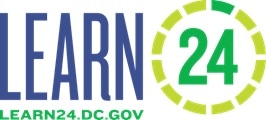
WE COMMIT TO A DECADE OF SERVICE TO THE YOUTH IN OUR PROGRAM.
Our Goal
The goal of City at Peace is to use the arts to develop a diverse group of effective leaders (ages 14-24) who can authentically collaborate, act, think, communicate, and solve challenges through non-violence in any life situation today and in the future to affect positive change.
Our Methodology
City at Peace uses theatre and the performing arts as a tool to examine social conditions that marginalize groups of people, with an emphasis on the marginalization of young people, to transform lives. Participants collaborate to engage in cross-cultural examinations, social awareness and social change strategies, non-violent conflict resolution, and leadership training in an effort to create understanding, accountability and forgiveness.
How we Serve
The City at Peace program is structured at its core, on four youth development principles. These principles have been recognized by the United Way of the National Capital Area and are as follows:
Self Development
Safety and Structure: A perception that one is safe in the world and that daily events are somewhat predictable.
- Feels safe in school, program and neighborhood
- Signs in and out of program
- Enforces rules and regulations with peers
Community Development
Belonging and Membership: A perception that one values, and is valued by, others in the family and in the community.
- Interacts easily with peers
- Joins or volunteers in one or more organizations or clubs
- Has one or more close friends
Building a Compelling Future
Mastery and Future: a perception that one is making it and will succeed in the future.
- Is able to identify three future goals and how to attain them
- Prepares for or asks questions about the future (e.g. When is the next test?)
- Is able to identify three recent accomplishments
Employability
The ability and motivation to gain the functional and organizational skills necessary for employment, including an understanding of careers and options and the steps necessary to reach goals.
- Schedules time and plans ahead
- Follows directions
- Negotiates and problem solves
Creating Positive Change through the Stage: A Conflict Resolution and Arts Teaching Framework for City at Peace
The City at Peace Guided Curriculum is a two-pronged, youth-driven approach steeped in examining unequal social conditions and leads to the creation of strategies to interrupt negative behaviors based on a non-violent approach and developing performing arts skills and technique, empowering youth to create a positive change in their communities.
The City at Peace curriculum framework is derived and driven by youth, co-facilitated by a friendly adult presence, or F.A.P. The framework is youth driven and includes philosophies derived from non-violent activists such as King and Gandhi and is supported by friendly adult presence.
The curriculum is offered in two units. Short-term outcomes are achieved in weeks 1-20, while Mid-term outcomes are achieved in weeks 21-40. Long-term outcomes are achieved beyond 40 weeks as young people’s conflict resolution and performing arts skills are refined and through participation in the Alumni Network and Mentorship programs.
Why did you join City at Peace?
Amyllah
It was community service but what made me stay was a whole different reason. What we talk about – it changes how I look at the world. And I just want to continue that. Continue to change how I think and how I move in the world.
Jaylen
I stayed because one I love the people, two it’s helping me build myself as a person and I definitely seee how this program is going to benefit me in the future.
Logan
I’m at City at Peace because my family encouraged me to join the program. And then it’s intriguing because of the relationships I’ve built through the program and I feel like it’s taken me a little bit outside of my comfort zone.
What ism have you learned about that has impacted you the most?
Amyllah
So I’m excited to talk about this – we talked about sexism – and we were having a little moment and basically I learned that sometimes your male are not your allies. We talked about how you can be an ally, like once the light was on that woman don’t see their male counterpart as allies we talked about how you can become an ally, what you can do, what women need from men. And one thing we need it for them not to check out.
 Jaylen
Jaylen
For me, I also learned a lot about sexism. I also learned there is a difference between being a friend and being an ally. It was not mind blowing but opening to see my female friends did not see me as an ally, even though I thought me myself as one. You have to basically defend their human right. It’s like, if someone is being sexist, let’s say a woman is getting less pay or she’s being treated as lesser because she’s a woman and men see them as objects. We have to come to their defense to make them feel like they’re safe, they’re more than what others think they are and make sure that they are able to get through life peacefully.
Logan
I feel like I learned a little more about ageism. Covering all the isms we talked about, I feel like being an ally was one of the major things I learned about what it means, how you can be one.
How will you go back into your communities knowing what you know?
Amyllah
I’m always spreading the word. I’m always telling people not what we talk about but how they move in the world, and just to like recognize it and stuff. I’m always preaching.
Jaylen
For me I’m definitely taking what we learn at City at Peace and giving it back out to the community. So I’ll try to help people one become allies, two, make sure they know the difference between what’s an ally and what’s a friend. And three just overall just be better people.
 Logan
Logan
I feel like my takeaway from City at Peace is that everyone’s experiences aren’t going to be the same as mine. Everyone won’t have the same triggers as I would. And I don’t have the same triggers as they do. So then taking away from City at Peace I know how to be more understanding.
What else do you want people to know about City at Peace? About you?
Amyllah
I want people to know that this group really changed me. And I think that it’s really good to join even though the hours are tedious, but I feel like it’s beneficial for sure. It really changes you as a person. It really changes your outlook on the world. I feel like that’s the biggest thing. Like every time we meet I think people should be here people should listen like people should know this stuff that we know. And just like how to move in the world better, accept more people. Really work out your traumas and your inner self like you really grow in the group. You grow with the people. You grow as a person.
Jaylyn
For me I just think that people should definitely join City at Peace because even though the material we talk about might be uncomfortable it is necessary to know in order to fully understand and make sure you know how to move through the world. And the community here is just so interconnected and so peaceful. Although there are times of tension we all end up working it out in the long run. I just want to say we are most likely going to be lifelong friends and that’s also another thing to look forward to.
Logan
I feel like being uncomfortable is all a part of the process of figuring things out learning and changing. Because if you don’t feel pressure nothing happens. And that kind of uncomfortable feeling is what we need to embrace that change.
 Introduce yourself
Introduce yourself
My name is Luke. I grew up in Silver Spring and have been living in DC proper for most of the last 15 years. I like to read books, run, and play guitar and am starting to relearn piano after a 25-year break. Since graduating from college in 2008, I’ve worked in international development.
When did you first participate in City at Peace? For how long?
I was in the 2003-04 cast, my senior year of high school.
What made you want to return to volunteer?
From 2016-2020, I lived overseas. During that time, I realized that one of the things I missed about being in DC was the community, and more specifically my ability to really dive in and participate in building the kind of community that I want to live in. The kind of community that I want to live in has things like City at Peace in it. After I moved back, Sandi and a couple of other alums were brainstorming ways to reengage the alumni more strongly in support of the organization and the cast. I started joining meetings with them and doing some outreach, but what I’d really always wanted to do was be what we used to call a friendly adult presence — someone who is around to support Sandi and the cast as they go on their journey together, in whatever way is needed. That title doesn’t really fit anymore, since the cast includes adults, so I guess you could just call it being a friendly presence. Sandi invited me to start coming in and I’ve been in most Wednesdays since.
What impact did the program have on you back then?
It completely changed my perspective on structural oppression and particularly on racism. It forced me to face parts of myself that were uncomfortable to look at, and to act in ways that were uncomfortable to act but that expanded my mind and heart.
What impact does the program have on you now?
That transformation never left me. The way that I move through the world, and DC in particular, is profoundly shaped by going through City at Peace. Among other things, it helped me be a useful quasi-cast member last year, after Sandi asked me to play the role of a “white dad” who was hung up on self-serving ideas of what racism and antiracism are. If you read the next answer, you’ll see why that hit close to home and how the program helped me contribute to the cast 18 years after I’d last been on stage.
What was one of your biggest takeaways from the program back then?
So many, but to pick one: As cringe-inducing as it feels to admit it now, as a teenager I thought that a black person stereotyping me or being mean to me because I’m white was “racist.” Sandi pointed out to me the other day that, when I came into the cast, I was uniquely attached to that idea. Had no trouble recognizing sexism, homophobia, ableism, and so on as structures that I benefited from, at others’ expense, as a cishet boy. But I clung to what I understood as the “dictionary definition” of racism. My struggle to unclench my grip on that idea and replace it with a truer understanding happened in City at Peace, out loud, surrounded by kids of different races who were (1) not having it and (2) not shutting me down out of hand. What I took away from that was not just a greater understanding of a defining characteristic of our society, but also that the kind of space City at Peace creates can be invaluable for growth and learning.
What have you observed to be a big takeaway from the program today?
Young people who’ve grown up through the pandemic and entirely immersed in social media have a different level of anxiety than people my age did back in the day. Not that we didn’t have anxiety and depression in my cast, of course, but it seems like the past couple of casts have had a harder time letting go of fear and inhibition and diving into the work. It’s also harder for them because the cast is so much smaller. We had something like 40 or 50 kids, which gives you a lot more opportunities to interact with different kinds of people, to practice the skills you’re learning, to build relationships. That said, it’s still inspiring to see kids challenging themselves and each other and the program is still helping them do that.
Why is City at Peace important?
City at Peace gives young people tools to understand themselves and the world that they don’t get elsewhere, it gives them a platform to share their stories and to be creative, and it challenges them to grow together, in partnership with each other. And it gives people who see the show and the families and friends of the cast the opportunity to learn about their loved ones and their community in a different way than we normally do.
Anything else you want to add?
Anyone reading this who’s associated with a school in the DMV, if you’re looking for a great program to either do yourself (if you’re under 24) or recommend to others (if you’re not), come to the show this summer. And the next cast starts in the fall!
“Living in Anacostia, transitioning from public to private school, and back again, I have been told that I would not live to see 18 years old by numerous adults in the school system when I was young. At 16, I became three things. The first was a father to a handsome, and now a successful, young sailor son. The second, a cast member of City at Peace. Finally, a 38 year old black man with a wife and child, working and attending college for game art and design. All of this without a criminal record or any negativity around me. A great deal of this is due City At Peace. This family (as I call them), IS the level of support and positivity that should be in the lives of ALL youth. It doesn’t matter if you are from D.C., Alexandria, Baltimore, or Great falls. I am forever grateful for their guidance, and allowing me to tap my potential through being realistic and direct in this form of Performing Arts. Especially Sandi. I love you, momma. Ginny Lee thanks you from beyond.”
Kassim (K.C.) McNeilCity
Peace Cast member: 1997-2002
“I have had the opportunity to work with many organizations that profess to want to help children and work with public schools. Most of them have high ideals and goals but have difficulty translating those ideas into reality as well as staying committed to working with our children. City at Peace, however, was able to talk the talk and walk the walk. On the first day, they were able to capture the hearts of our children and kept that fire burning until the end of the program. They were able to maintain a high standard of behavior and expectations, kept students engaged and active, and presented a rigorous, thought-provoking, insightful curriculum that made a lasting impression on the students.
The true reflection of the success of any program is the testimony of the young people involved. They are brutally honest and if they don’t feel that your program has value, they will not attend. Our students came to the sessions religiously, even when we had to alter the meeting site because of schedule conflicts. In fact, a student even came to class after they had taken their finals for their academic courses. When I talked to the students and asked if they wanted to bring the program back next year they ALL enthusiastically replied yes!”
Dr. Maurice Butler
Theodore Roosevelt High School
“City at Peace gave me a purpose in life. It gave me vocabulary for things I had been feeling and gave me a way to express that is healthy, fun, and sometimes hard, but very necessary.”
Program Participant
“I grew by leaps and bounds. I learned how to listen and empathize. I learned how to share my life story without feeling self-conscious. I learned how to cast away prejudice, and accept that young people are complex, that there is no binary of ‘good’ or ‘evil.’ I learned how to be silly, and spontaneous. I learned that social justice and peace are lifestyle choice, and not activities.”
Program Participant
Graham Holdings Company
Michael Blum
Rappaport
Eric Jaffe and Rebecca Gitner
Jane Lang
Eugene M. Lang Foundation
Craig Pascal in memory of Victor Shargai
Michael and Monique Watson
PEPCO
The Strebor Family Foundation


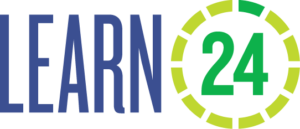
City at Peace went virtual in 2020 in response to the ongoing pandemic due to Covid-19. What was once bi-weekly in-person meetings for 15-20 participants in our theater is now a virtual zoom experience for over 30 cast members. Participants worked through extensive online coursework and conversations about the challenges they face including discrimination, sexism, classism, and ageism. We sat down with production team members of City at Peace to learn more about their experience this season.
 “Human interaction. I have not hugged another person in almost a year.” Mych, 18
“Human interaction. I have not hugged another person in almost a year.” Mych, 18
“Believe it or not I’m actually very thankful for school. Because without it, during last year, there would have been way too much time on my hands. And it just would have been – it would have been the true definition of wasting time. I’d be searching for things to do.” Francis, 14
“Something I couldn’t live without is my sketchbooks. because during 2020, you couldn’t really go out, and so because of all the time I had I would draw.” Jaiden, 15
“One thing I couldn’t live without in 2020 was music. I was listening to music all the time, all day.” Kaileb, 15
 “Once thing that I’m not going to be bothered by anymore, if I’m with my friends or if I’m with a group of people and their gonna be like ‘you’re too loud or you’re being way too energetic’, I feel like I won’t be bothered by that anymore. I feel like I’d be like, ‘yeah that’s the point!’ I feel like I’ll just be just be high energy, just way high energy now.” Jaiden, 16
“Once thing that I’m not going to be bothered by anymore, if I’m with my friends or if I’m with a group of people and their gonna be like ‘you’re too loud or you’re being way too energetic’, I feel like I won’t be bothered by that anymore. I feel like I’d be like, ‘yeah that’s the point!’ I feel like I’ll just be just be high energy, just way high energy now.” Jaiden, 16
“I think it’s going to be a privilege to leave the house.” Francis, 14
“I used to hate practice, like baseball practice and football practice, I would just want to play in the games but now I just really want to go back to practice and I will never complain about having to practice again because I miss it so much now. ” Kaileb, 15
“I’ll probably never complain about tech week. I have a love-hate relationship with tech week, it’s always fun because the cast gets along, rehearsals are the same time but they feel longer and always something goes wrong.” Mych, 18
“I’ll probably never complain about having to school again. I miss it. I miss interacting with my friends.” Kayla, 16
“I’m not going to be annoyed by noise around me. Like I miss hearing noise. Cars honking people yelling at each other. I just miss that kind of interaction.” Jailah, 16
“Before Covid I didn’t like to go to my practice for choir because it was every Saturday night and I was ‘like bro it’s Saturday’! I just miss my practice. We haven’t done any practice since April of last year.” Veronica, 15
 “I feel like there is a whole different experience being in person, you get that rush, and you can really feel the pure raw emotion of whatever you’re seeing whether it’s a theater performance or a concert or a sports game. You get that rush and then you can also feed off of the energy beside you. For example, I’ve seen Hamilton online but I’ve talked to my friends who have seen and they’re like ‘it’s amazing!’ and I want to have that experience.” Jaiden, 15
“I feel like there is a whole different experience being in person, you get that rush, and you can really feel the pure raw emotion of whatever you’re seeing whether it’s a theater performance or a concert or a sports game. You get that rush and then you can also feed off of the energy beside you. For example, I’ve seen Hamilton online but I’ve talked to my friends who have seen and they’re like ‘it’s amazing!’ and I want to have that experience.” Jaiden, 15
 “I have learned so much here. I’ve further developed a mindset about society. I said some really profound things that never thought that I would say at City at Peace. And I also found a bit more about myself, one of the things Ms. Sandi told me a couple of sessions ago, “don’t hold yourself back for the likes of others” because you were talking about people speaking out, unmuting their mics, and speaking out what they’re thinking and I said, ‘oh I can dial it back”‘ and Ms Sandi said ‘no, be yourself, don’t ever hold yourself back.’ And I was like ‘Wow. OK. I guess I needed someone to say that to me.’ This program has helped me further advance my thoughts about things happening in the world. I think I would be a bit more insecure about speaking out about things if it weren’t for City at Peace.” Jaiden, 15
“I have learned so much here. I’ve further developed a mindset about society. I said some really profound things that never thought that I would say at City at Peace. And I also found a bit more about myself, one of the things Ms. Sandi told me a couple of sessions ago, “don’t hold yourself back for the likes of others” because you were talking about people speaking out, unmuting their mics, and speaking out what they’re thinking and I said, ‘oh I can dial it back”‘ and Ms Sandi said ‘no, be yourself, don’t ever hold yourself back.’ And I was like ‘Wow. OK. I guess I needed someone to say that to me.’ This program has helped me further advance my thoughts about things happening in the world. I think I would be a bit more insecure about speaking out about things if it weren’t for City at Peace.” Jaiden, 15
More interview Q & A’s coming soon.

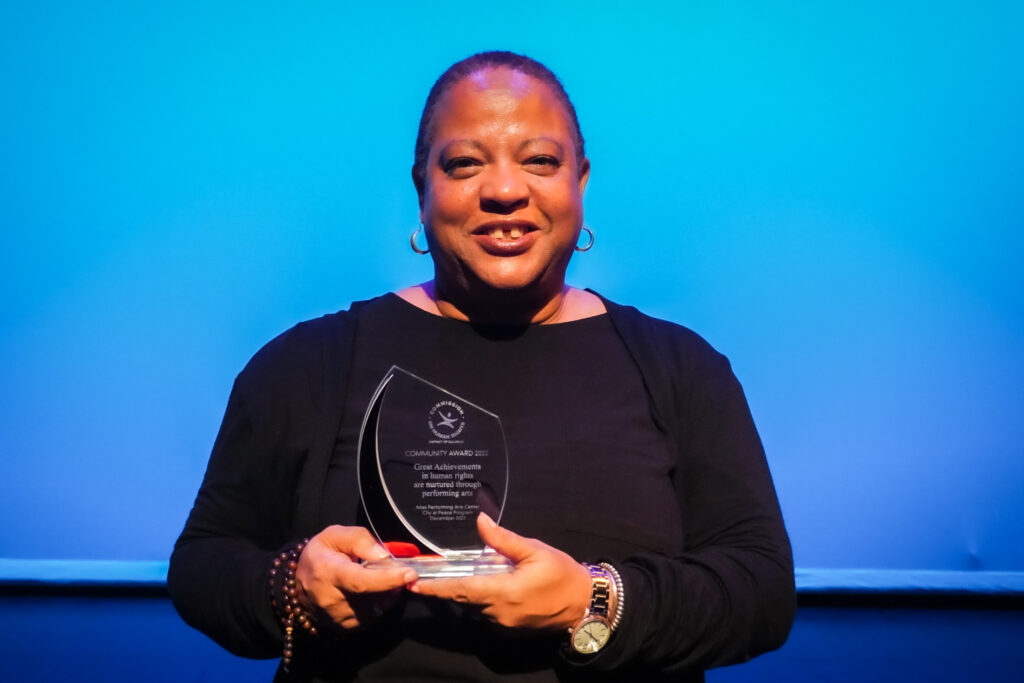
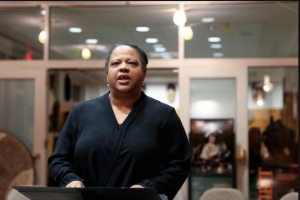 Program Director: Sandra Holloway
Program Director: Sandra Holloway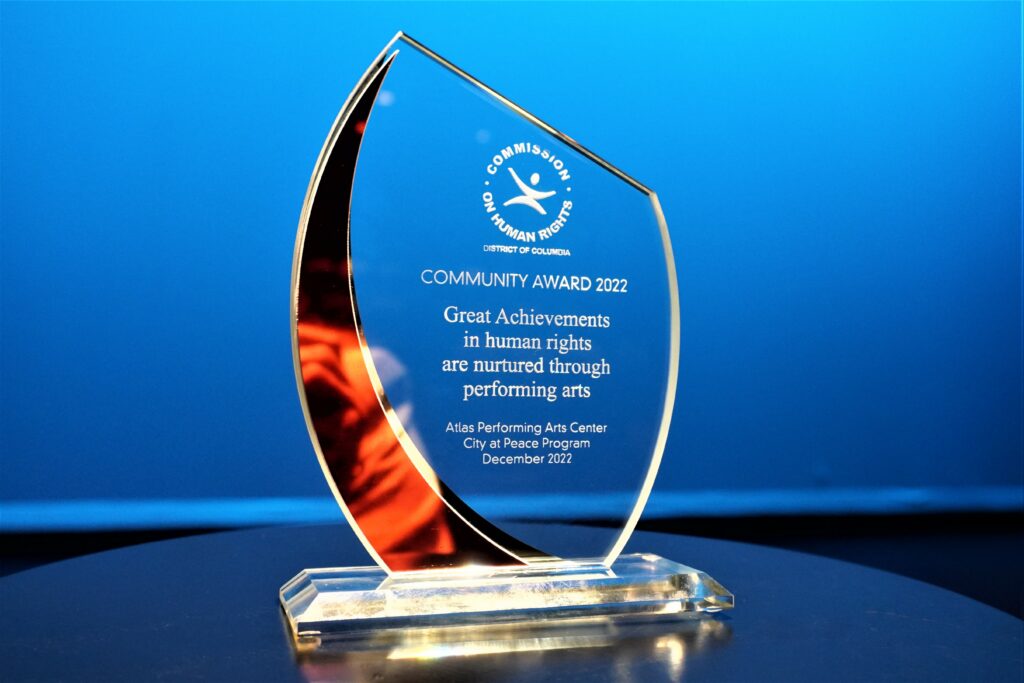
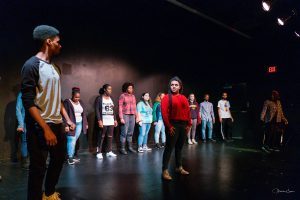
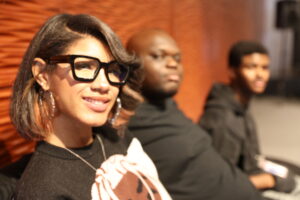
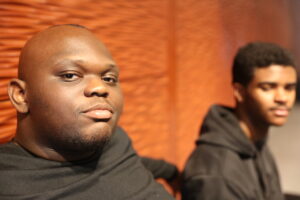 Jaylen
Jaylen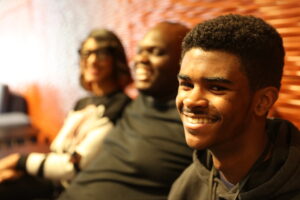 Logan
Logan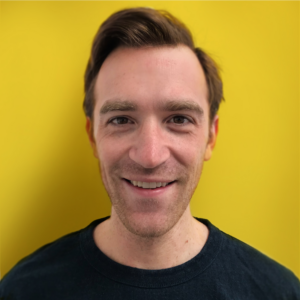 Introduce yourself
Introduce yourself
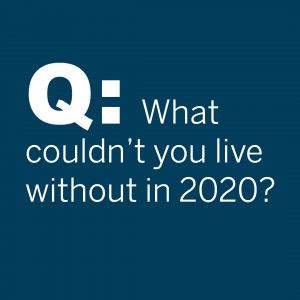 “Human interaction. I have not hugged another person in almost a year.” Mych, 18
“Human interaction. I have not hugged another person in almost a year.” Mych, 18 “Once thing that I’m not going to be bothered by anymore, if I’m with my friends or if I’m with a group of people and their gonna be like ‘you’re too loud or you’re being way too energetic’, I feel like I won’t be bothered by that anymore. I feel like I’d be like, ‘yeah that’s the point!’ I feel like I’ll just be just be high energy, just way high energy now.” Jaiden, 16
“Once thing that I’m not going to be bothered by anymore, if I’m with my friends or if I’m with a group of people and their gonna be like ‘you’re too loud or you’re being way too energetic’, I feel like I won’t be bothered by that anymore. I feel like I’d be like, ‘yeah that’s the point!’ I feel like I’ll just be just be high energy, just way high energy now.” Jaiden, 16 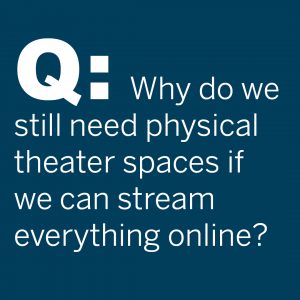 “I feel like there is a whole different experience being in person, you get that rush, and you can really feel the pure raw emotion of whatever you’re seeing whether it’s a theater performance or a concert or a sports game. You get that rush and then you can also feed off of the energy beside you. For example, I’ve seen Hamilton online but I’ve talked to my friends who have seen and they’re like ‘it’s amazing!’ and I want to have that experience.” Jaiden, 15
“I feel like there is a whole different experience being in person, you get that rush, and you can really feel the pure raw emotion of whatever you’re seeing whether it’s a theater performance or a concert or a sports game. You get that rush and then you can also feed off of the energy beside you. For example, I’ve seen Hamilton online but I’ve talked to my friends who have seen and they’re like ‘it’s amazing!’ and I want to have that experience.” Jaiden, 15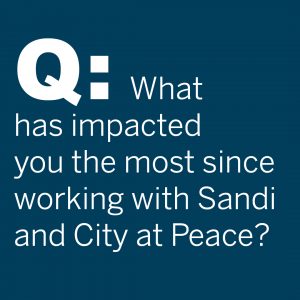 “I have learned so much here. I’ve further developed a mindset about society. I said some really profound things that never thought that I would say at City at Peace. And I also found a bit more about myself, one of the things Ms. Sandi told me a couple of sessions ago, “don’t hold yourself back for the likes of others” because you were talking about people speaking out, unmuting their mics, and speaking out what they’re thinking and I said, ‘oh I can dial it back”‘ and Ms Sandi said ‘no, be yourself, don’t ever hold yourself back.’ And I was like ‘Wow. OK. I guess I needed someone to say that to me.’ This program has helped me further advance my thoughts about things happening in the world. I think I would be a bit more insecure about speaking out about things if it weren’t for City at Peace.” Jaiden, 15
“I have learned so much here. I’ve further developed a mindset about society. I said some really profound things that never thought that I would say at City at Peace. And I also found a bit more about myself, one of the things Ms. Sandi told me a couple of sessions ago, “don’t hold yourself back for the likes of others” because you were talking about people speaking out, unmuting their mics, and speaking out what they’re thinking and I said, ‘oh I can dial it back”‘ and Ms Sandi said ‘no, be yourself, don’t ever hold yourself back.’ And I was like ‘Wow. OK. I guess I needed someone to say that to me.’ This program has helped me further advance my thoughts about things happening in the world. I think I would be a bit more insecure about speaking out about things if it weren’t for City at Peace.” Jaiden, 15